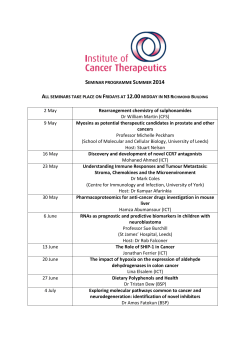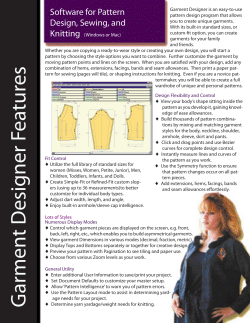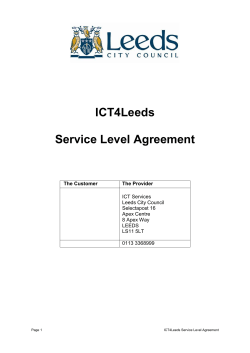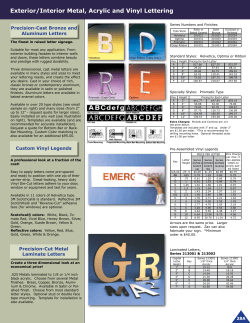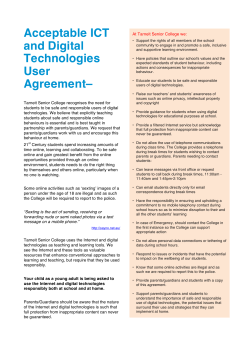
UNDERGRADUATE PRIMARY TEACHERS’ LEARNING STYLES SOFTWARE.
UNDERGRADUATE PRIMARY TEACHERS’ LEARNING STYLES AND THEIR USE OF ICT & NATIONAL MATHEMATICS SOFTWARE. Doukakis Spyros*, Dr Chionidou - Moskofoglou Maria**, Dr Eleni Mangina-Phelan*** sdoukakis@rhodes.aegean.gr, mchionidou@rhodes.aegean.gr, eleni.mangina@ucd.ie * PhD Candidate, Dept. of Primary Education, University of the Aegean, Greece ** Assistant Professor, Dept. of Primary Education, University of the Aegean, Greece *** Senior Lecturer, School of CS and Informatics, University College Dublin, Ireland Abstract This research project was conducted at the Department of Primary Education, at the University of Aegean. The 234 participants consisted of undergraduate primary school teachers. Their learning styles, their attitudes, as well as their self-efficacy in relation to ICT and the Mathematics Educational Software of the Pedagogical Institute were studied using four research instruments. The results show that students learning styles are mainly sensing, visual, sequential and active. Furthermore, it seems that students are well acquainted with the use of ICT and have, therefore, a positive attitude. Statistical significant differences were observed between the visual learning style and the use of ICT, and also between males and females. Introduction Over the past few decades, one of the most important issues related to educational change and educational innovation is the incorporation of ICT (Black & McClintock, 1996; Jonassen et al., 1999; Hoyles, Noss & Kent, 2004). ICT constitutes an essential tool for teachers of mathematics, too, since it can be used as: a) an educational method to support student learning; b) as a personal tool to prepare material for his lessons, to manage a variety of projects electronically and to search for information; c) as a tool to collaborate with other teachers or colleagues (Da Ponte, Oliveira & Varandas, 2002). According to NCTM (2000), ICT can encourage the development of significant abilities in students, develop a positive attitude towards maths and contribute to the way students view mathematics. In order to take advantage of ICT in mathematics, in-service and pre-service teachers must familiarise themselves with the potentials of ICT in the teaching of mathematics so as to become more confident. They must also know how to use such ICT tools as office management software as well as Mathematics Educational Software (NCTM, 1991). According to Mishra & Koehler (2006), to achieve the above goals it is essential that the relations among users, technologies, practices and tools be understood, since “…technology is a knowledge system that comes with its own biases, and affordances…”. (Mishra & Koehler, 2006, p. 132). Recently, research in educational technology suggests the need for “Technological Pedagogical Content Knowledge” (TPCK), which is based on Shulman’s (1986) idea of “pedagogical content knowledge”, so as to incorporate technology in pedagogy (e.g., Keating & Evans, 2001; Niess, 2005; Mishra & Koehler 2006; Cavin, 2007, Angeli & Valanides, 2009). This interconnectedness among content, pedagogy and technology has important effects on learning as well as on professional development (Mishra & Koehler, 1 2006). They suggest “…a curricular system that would honour the complex, multi-dimensional relationships by treating all three components in an epistemologically and conceptually integrated manner” and they propose an approach which is called “Learning technology by design” (Mishra & Koehler, 2006, p. 1020). In Greece, the educational changes of 2003 led to the “Cross-thematic Curriculum for Compulsory Education, CCTF”, which has been implemented in compulsory education since 2006. One of its general principles is “to prepare pupils to explore new information and communications technologies” (Official Government Gazette, 2003, p. 1). In its effort to implement this new educational policy the Pedagogical Institute has developed textbooks and educational software (E.S.) for all teaching subjects. The educational software produced is not solely for the teaching of mathematics but is also for consolidation and supplementation and has been designed so as to complement and at the same time make use of the teaching materials for the teaching of mathematics in primary education (Chionidou, Zibidis, & Doukakis, 2007). The Educational Software of the Pedagogical Institute for Mathematics (E.S.P.I.M.) consists of three independent E.S., one for every second grade. Except for the educational software for the first two grades, the other two software applications are based on micro-worlds. According to Kynigos (2007, p. 90), “Micro-worlds are computational environments embedding a coherent set of scientific concepts and relations designed so that with an appropriate set of tasks and pedagogy, students can engage in exploration and construction activity rich in the generation of meaning” Therefore, from a constructivist viewpoint, E.S.P.I.M. integration into 4th year undergraduate student teaching practice is a crucial factor for teachers’ future “establishment” and improvement in maths classroom practices. It is this factor that the researchers of this project have begun to investigate. During the first phase of the research project the following questions were investigated: a) student learning styles, b) student attitudes towards ICT, c) student selfefficacy towards ICT and d) student attitudes towards Mathematics Educational Software. This paper presents the results concerning student learning styles, their attitudes towards ICT and their efficiency in its usage. Furthermore, the correlation and statistically significant differences in student learning styles, attitudes and their self-efficacy towards ICT will be illustrated. Finally, a reference will be made to the approach towards TPCK development among undergraduate students as well as to the research questions that emerged from the first stage. Learning styles A learning style is described as a set of intellectual and emotional characteristics as well as of psychological factors used as indicators of a student’s perception, inter-relatedness with and response to the learning environment (Keefe, 1979). The more we understand and know about a student’s personal stance towards learning, the more we can contribute towards his/her success. Several research studies have attempted to categorise students according to their learning styles with positive results not only for the understanding of these styles but also for their improvement. Dunn and Dunn (1978) presented a comprehensive model that incorporates the study of environmental, 2 emotional, sociological, physical and psychological factors. Kolb (1984) defined four learning styles (accommodation, assimilation, converging, and diverging) and four learning modes (concrete experience, reflective observation, abstract conceptualization, and active experimentation). Since then quite a few models investigating learning styles have been developed, all of which come to the same conclusion: the more we know about student learning styles, the more aware we are of the differences in class. This way, the educator/teacher can systematically design/prepare his/her lessons so as to achieve learning by combining his/her students’ learning styles (Mangina & Mowlds, 2007). Moreover, it is argued by several researchers that learning styles must be in accord with teaching styles (Griggs and Dunn, 1984; Charkins et al., 1985). In table I, Felder & Silverman, (1988) present the dimensions of teaching and learning styles. In this model there are 25 learning styles. It is impossible for the teacher to adapt his/her teaching to all 32 different styles; yet his/her goal is to have an overview of his/her class and to adapt his/her teaching as required. Table I. Dimensions of teaching and learning styles Preferred learning Sensory/intuitive Visual/auditory Inductive/deductive Active/reflective Sequential/global Style Perception Input Organization Processing Understanding Corresponding teaching Concrete/abstract Visual/verbal Inductive/deductive Active/passive Sequential/global Style Content Presentation Organization Student participation Perspective (Source: Felder & Silverman, 1988) In general, students prefer to receive and process information in different ways: by seeing and hearing, reflecting and acting, reasoning logically and intuitively, analyzing and visualizing. Yet criticism of this categorisation is valid, as e-learning environments have proven to enhance the teaching and learning, especially for groups from different cultural backgrounds (Mangina & Mowlds, 2007). Furthermore, what is crucial is not just to be aware of student learning styles, but rather to identify and study those methods that will contribute to the improvement of these styles, based on our knowledge of their learning styles. In this paper, the investigation of student learning styles does not aim at their identification alone, but more so to those actions that will follow and will have a strong pedagogical impact on the cycle of learning as well as the development to TPCK. Attitudes towards ICT Investigating learning styles is of great importance for the development of TPCK and the incorporation of E.S.P.I.M. into the teaching practice of fourth year undergraduate students. Yet the success of this endeavour is directly correlated to the involvement and attitude of the student. It is argued that unless ICT conforms with the students’ beliefs and attitudes, it will not be incorporated in their teaching and learning (Yuen, Law & Chan, 1999). Another factor is attitudes towards ICT (Huang & Liaw, 2005). Attitudes depend on a variety of issues such as the usefulness of ICT and confidence in using it (Rovai & Childress, 2002), training and knowledge of ICT (Tsitouridou & Vryzas, 2003; Yuen, Law & Chan, 1999), anxiety and confidence (Roussos, 2007). 3 Regardless of ICT availability in schools what is of primary importance is the teachers’ positive attitude towards ICT, so as to include it in the school curriculum. According to researchers, teacher attitude towards ICT is a predictor for future computer use in the classroom (Myers & Halpin, 2002; Khine, 2001). In Greece, Roussos (2007) designed the Greek computer attitudes scale. Using questions from other scales as well as introducing new scales, he based his model on three subscales: confidence, affection, and cognitive. Furthermore, in a study of 184 pre-service teachers, Khine (2001) found a significant relationship between computer attitude and its use in university laboratories. Kumar and Kumar (2003) report that teachers themselves believe that their experience in using ICT will positively affect their attitude towards ICT. Teo (2008) examined a sample of 139 pre-service teachers for their computer attitudes with four factors: affect (liking), perceived usefulness, perceived control, and behavioural intention to use the computer. It seems, therefore, that the study of undergraduate student attitudes towards ICT plays an important role in its incorporation into the teaching practice. However, as has already been mentioned, student efficacy in using ICT constitutes a factor in the formulation of their attitude and eventually in the incorporation of ICT in the classroom. It seems, therefore, that their attitude and self-efficacy together constitute a force that needs strengthening if ICT is to be incorporated in their teaching (Mishra & Koehler, 2006). ICT Self-efficacy In order to have a complete student-teacher profile, the ICT self-efficacy of the undergraduate students formed the third parameter of the investigation. According to Bandura (1997), who first discussed the notion of self-efficacy, "perceived self-efficacy refers to beliefs in one's capabilities to organize and execute the courses of action required to produce given attainments" (p. 3). As suggested by Bandura, self-efficacy is specific to a particular set of behaviours and comprises two components, efficacy expectations and outcome expectations which respectively relate to belief in personal capacity to effect a behaviour and belief that the behaviour will result in a particular outcome (Huey-Wen Chou & Tsung-Bin Wang, 2000). Apparently, the study of ICT self-efficacy constitutes an important factor in the teachers’ decision to use ICT in class (Hill, Smith, & Mann, 1987). Furthermore, ICT performance seems to be related to ICT self-efficacy (Harrison, et al., 1997). A Greek instrument including several sub-scales for self-efficacy in relation to particular aspects of computer use has been developed and validated with students, teachers and individual persons (Kassotaki & Roussos, 2006). This research tool was used in this research study. Data collection methods, research results as well as the emergence of the next set of research questions are presented in the following paragraphs. Methods The research sample consists of students at the Department of Primary Education, at the University of Aegean in Greece; all students have signed up for the courses Problem-solving in Mathematics and Second Stage Practicum. All in all, 325 students have registered in the fall semester of the 2008-2009 academic year. Out of these students, 234 completed the three research tools; in other words, 72%. Questionnaires were completed during the first meeting with the teacher and were anonymous. Unlimited time was allowed for each session, with most pre-service teachers finishing all the scales within 40 minutes. 4 Instruments Four separate instruments were used to obtain the data. Furthermore, participant demographics were obtained related to their gender, high-school preference for a specific category of departments in universities (sciences, technological, theoretical), age and semester of current studies. The first instrument was Index of Learning Styles, (Felder & Silverman, 1988). ILS is a self-scoring 44 item questionnaire for assessing preferences for four dimensions of the Felder and Silverman (1988) model. Students may have a mild, moderate or strong preference for each dimension. These four dimensions are active and reflective learners; sensing and intuitive learners; visual and verbal learners; and sequential and global learners. Platsidou and Zagora (2006) translated the tool in Greek, which was used to this study. The second instrument was Greek Computer Attitude Scale (GCAS) (Roussos, 2007). GCAS is a scale devised to measure attitudes toward computers in the Greek population. The scale is presented as a list of 30 items, with three subscales: confidence, affection, and cognitive (Roussos, 2007). An answer scale of 1-5 was given to the participants; 1 stood for ‘I completely disagree’, on the left-hand side of the scale and 5, on the other side of the scale, stood for ‘I completely agree’. The 30 items of the GCAS are summed to provide a total score representing the participant’s overall attitude toward computers (ranging from 30 to 150), whereas scores from items on each subscale are summed to provide individual scores on each attitude construct. The third tool was Greek Computer Self-Efficacy Scale (GCSES) (Kassotaki & Roussos, 2006). GCSES is a list of 29 items with two subscales: computer knowledge and computer usage and devised to measure self-efficacy towards computers in the Greek population (Kassotaki & Roussos, 2006). The 29 items of the GCSES are summed to provide a total score representing the participant’s overall self-efficacy toward computers (ranging from 29 to 145). An answer scale of 1-5 was given to the participants; 1 stood for ‘None at all’, on the left-hand side of the scale and 5, on the other side, stood for ‘Great’. The last tool was Greek Mathematics Educational Software Attitude Scale (GMESAS). GMESAS is a list of 29 items and is devised to measure attitudes toward Educational Software in Mathematics in the Greek population. The 29 items of the GMESAS are summed to provide a total score representing the participant’s overall attitude toward Mathematics Educational Software (ranging from 29 to 145). An answer scale of 1-5 was given to the participants; 1 stood for ‘I completely disagree’ on the left-hand side of the scale while 5 stood for ‘I completely agree’. In order to validate the tools and methodology, a pilot study was conducted before all students were asked to complete the questionnaires; all four research tools were used. The fourth research tool was tailor-made for this research study and once it has been further developed through principal component analysis (PCA), the relevant results will be presented. In the following paragraphs, the results concerning the first three research tools as well as the demographics are presented and discussed. Results Statistical Package for Social Science (SPSS) was used to analyze the data and answers given to the negative items in the scales were inverted at grading. Simple t-tests were used when it was essential, correlation techniques and 5 ANOVA test of statistical significance were used to determine "whether any differences among two or more means are greater than would be expected by chance", (Walsh, 1990, p. 124). In the following paragraphs, the results concerning student learning styles, attitudes toward ICT and student selfefficacy are presented. Demographics The last section of the instruments contained several demographics questions addressing gender, age, semester of studies. Of the 234 survey responses, 83.8% of the undergraduate students were female. Of the 234 students, 220 (94% of the) participants were between 19 and 22 years old. The majority of the students (66.2%) had attended the theoretical module at school, while 18.8% and 15% originated from the sciences and technological module respectively. Table II presents a profile of the students in the study using a cross-tabulation with the Index of Learning Styles categories. Table II. Characteristics of the Sample Index of Learning Styles (ILS) Active Reflec Sensing Intuitive tive N N N N Visual Verbal Global N Sequential N N N By Gender Male 22 Female 113 16 83 28 169 10 27 34 136 4 60 22 131 16 65 Total 99 197 37 170 64 153 81 By Direction (Science: Sc, Technological: Te, Theoretical: Th) Sc 27 17 41 3 38 6 Te 24 11 27 8 29 6 Th 84 71 129 26 103 52 23 15 115 21 20 40 Total 153 81 135 135 99 197 37 170 64 Descriptive analysis of the Index of Learning Styles The results from the students (as provided in Table II) showed that the students had a preference of active learning, which means that they learn by doing things and enjoy working in groups, whereas 42% is learning by thinking things through and they work better alone or with a familiar partner. The second dichotomy divides students into sensing or intuitive learners. Most of the students tend to like learning facts. They are concrete thinkers and quite practical. Only 16% were intuitive learners, that means they discover possibilities and relationships, they think in an abstract manner, they are innovative and work faster. Thirdly, a majority of the students (73%) are visual, in that they prefer representations of presented material, such as pictures, diagrams and flow charts. They remember what they see. Verbal learners (27%), on the other hand prefer written and spoken information. Finally, the last dichotomy consists of sequential and global learners. Sequential learners (65% for those students) have a linear thinking process, they prefer to gain understanding in steps. They follow logical stepwise paths to find solutions. The 35% were global learners, learn in large jumps, they absorb material randomly without seeing connections then suddenly gain the understanding. They solve complex problems quickly once they have grasped the big picture. 6 Computer Attitudes of Pre-service School Teachers The GCAS, was subjected to multifactorial principal component analysis with varimax rotation for item analysis. The Kaiser-Meyer-Olkin measure of sampling adequacy was used to assess the adequacy of the correlation matrices for factor analysis (ΚΜΟ = 0.912). Bartlett’s test of sphericity (X2 = 4079.67, df = 435, p <.001) reject the hypothesis that the correlation matrix is an identity matrix. The principal components analysis of the 30 variables has as a result of 3 factors with eigenvalues greater than one. The three factors explain nearly 52% the variability in the original 30 variables. The reliability was examined with Cronbach Alpha. The three factors have reliability between 0.917 and 0.866. The Varimax rotation is used to orthogonally transform the factor subspace and to interpret the physical meaning of each factor without altering the results. The three factors, which are the same with Roussos (2007) results, are: 1. Affection group: participants with computer anxiety and feelings such as unease, threat, irritation, and incompetence with respect to computers. 2. Confidence group: participants who are confident with computers; some of these items concerned degree of engagement with computing. 3. Cognitive group: participants’ perceptions about computing and computers. Descriptive analysis of the Greek Computer Self-Efficacy Scale The Greek Computer Self-Efficacy Scale counts student self-efficacy towards ICT on a scale of 29 (no knowledge) to145 (very good knowledge). For the purpose of this analysis, answers were grouped into four scoring groups (little, average, good, very good knowledge). The results (as illustrated in Table III) showed that 85% of students assess their ICT knowledge as ‘good’ or ‘very good’. Table III. Greek Computer Self-Efficacy Scale Scores 29 - 57 58 - 86 87 - 115 116 - 145 Frequency 2 33 88 111 Percent 0.9 14.1 37.6 47.4 Correlation analysis A Pearson correlation was used to determine correlations among learning styles, computer attitude and self-efficacy. The correlation analysis did not suggest a strong correlation between learning styles and factors that emerged from the analysis of both the ICT attitudes scale and the self-efficacy in ICT usage scale. It is worth noting that an average negative correlation between the visual/verbal learning styles and self-efficacy (r = -0.27, df = 228, p < 0.001), an average negative correlation between visual/verbal learning styles and factor 2 (confidence) (r = -0.28, df = 228, p < 0.001), as well as an average positive correlation between visual/verbal learning styles and factor 1 (affection) (r = 0.25, df = 228, p = 0.025) were found. Finally, an average positive correlation is observed between the sensing/intuitive learning styles and factor 1 (affection) (r = 0.29, df = 228, p = 0.004). The Differences of Undergraduate Teachers’ Attitudes towards ICT In Relation to Their Learning Styles A t-test was used to compare the mean value among the groups of learning styles, computer attitudes towards ICT and computer self-efficacy. 7 The mean value score of a visual learning style (M = 0.16, SD = 1.01) was found to be statistically significant (t = 4.35, df = 232, p < .001) compared with that of a verbal learning style (M = -0.45, SD = 0.79) with regard to factor 2 (confidence). Moreover, the mean value score of males (M = 0.4, SD = 0.98) was found to be statistically significant (t = 2.64, df = 228, p = .001) compared with that of females (M = -0.74, SD = 0.98) with regard to factor 2 (confidence). Finally, a one-way ANOVA was used to identify whether the group means of each school module differed with regard to learning style. The analysis shows a significant difference between the visual and verbal learning style group (F2, 231 = 4.62, p = 0.011). A Bonferroni adjustment is used to indicate that the significant difference is between the means of students from the science and theoretical modules. Moreover, there is a significant difference between the sequential and global learning style group (F2, 231 = 8.76, p < 0.001). A Bonferroni adjustment indicates that the significant difference is between the means of students from the theoretical group as opposed to the other two groups. Discussion The analysis results show that the least common/frequent student learning styles are the intuitive (16%), the verbal (27%) and the global style (35%). It seems that undergraduate students like learning facts, following proven methods of exploration and problem solving, are good at memorization and are careful and practical learners who like real world connections. Moreover, most of the students are visual, which means that they learn best from what they can visualise, and, therefore, like charts, graphs, pictures, films, and demonstrations. Finally, they are sequential, which means that they like the information presented in linear steps while at the same time they need some help in putting the “larger” picture together. With regard to their ICT self-efficacy, it seems that students have already acquired the necessary knowledge of ICT usage before entering university or during their university studies and are, as a result, comfortable with using them. Consequently, it seems that using and familiarizing oneself with ICT are a given among students today as compared to students of the past. Perhaps this explains the lack of a significant correlation between learning styles and student attitudes towards ICT. The statistically significant differences observed in ICT confidence between the visual and verbal style strongly suggest that feeling confident in using ICT positively correlates to a visual learning style. Furthermore, despite the fact that women have a stronger ICT self-efficacy in comparison to that of men, it is the latter who appear more ICT confident. All in all, the descriptive data seem to be supported by the current literature (Ross & Lukow, 2004; Tripp & Moore, 2007; Young, Sanders & Hausler, 2008). In any case, the insignificant differences between learning styles and student attitudes towards ICT are worth noting. It is obvious that research limitations (the fact that students might have taken advantage of ICT in other courses they chose to follow during their studies as well as the fact that they were selected from one university department) do not permit a generalisation of the findings to other student populations or other universities. 8 Conclusion The investigation of student learning styles in this research study had two major aims: first, to allow students to experience and learn through this experience about the various learning styles so that they can be aware and capable of converting this awareness into practice in their own classrooms as future teachers; second, to develop their TPCK so they can incorporate ICT in their own teaching. According to Mishra & Koehler (2006), acquisition and development of TPCK presuppose a dynamic and complex knowledge on the part of the teacher. TPCK development in students follows the Mishra & Koehler (2006) model, its defining feature being the active participation of the students in the entire process. Through learning by doing, the actual teaching using two different approaches, the first one using paper and pencil, whereas the second one making use of educational software and other computer tools, an attempt is made to engage the students in a rich teaching environment. In addition, after the end of each lesson, students complete a feedback sheet as well as a second sheet that examines their attitudes towards the lesson and the usage of alternative teaching tools. Apart from the webpage and email communication, the lesson has been enriched with a forum, a blog as well as communication via sms. All of the above opportunities for student involvement with ICT as well as their projects will lead to the design of educational scenarios; whether or not these contribute to the acquisition and development of TPCK will be investigated. Furthermore, group discussions as well as the qualitative analysis of both the interviews and the discussions contribute to the group dynamics (Mishra & Koehler, 2006). Whether or not a learning environment rich in technological tools and student support in the design of authentic educational scenarios, where ICT usage is embedded, allows students to draw the necessary connections between on the one hand, technology and mathematics, but also technology and pedagogy, so as to incorporate technology in their teaching, is one of the goals of this research programme. References Angeli, C. & Valanides, N. (2009). Epistemological and methodological issues for the conceptualization, development, and assessment of ICT-TPCK: Advances in technological pedagogical content knowledge (TPCK) Computers & Education, 52(1), 154-168. Bandura, A. (1997). Self-efficacy: The exercise of control. New York: Freeman. Black, J. B. & McClintock, R. O. (1996). An interpretation construction approach to constructivist design. In B. G. Wilson (Ed.), Constructivist Learning Environments: Case studies in instructional design. Englewood Cliffs, NJ: Educational Technology Publications. Cavin, R. M. (2007). Developing technological pedagogical content knowledge in preservice teachers through microteaching lesson study. Doctoral Dissertation, Florida State University, Tallahassee, FL. Retrieved January 10, 2009, from http://www.chipola.edu/instruct/math/cavin Charkins, R. J., O’Toole, D. M., & Wetzel, J. N. (1985). Linking teacher and student learning styles with student achievement and attitudes. The Journal of Economic Education, 16(2), 111-120. Chionidou, M., Zibidis, D., & Doukakis, S. (2007). Greek primary teachers’ embedding mathematical software. Shulman’s categories and Habermasian 9 interests. In: E.P. Avgerinos and A. Gagatsis (eds.) (2007). Current trends in Mathematics Education. Proceedings of 5th MEDCONF 2007 (Mediterranean Conference on Mathematics Education), 13-15 April 2007, Rhodes, Greece. Athens: New Technologies Publications pp. 235-243. Chou H. W. & Wang T. B. (2000), The influence of learning style and training method on self-efficacy and learning performance in WWW homepage design training, International Journal of Information Management, 20(6), 455-472. Da Ponte, J. P., Oliveira, H. Oliveira & Varandas, J. M. (2002). Development of Pre-Service Mathematics Teachers’ Professional Knowledge and Identity in Working with Information and Communication Technology, Journal of Mathematics Teacher Education, 5: 93-115. Dunn, R. & Dunn, K. (1978), Teaching Students through their Individual Learning Styles: A Practical Approach, Reston Publishing, Reston, VA. Felder, R. M. & Silverman, L. K. (1988), Learning and teaching styles in engineering education, Engineering Education, 78(7), 674-681. Griggs, S.A. & Dunn, R.S. (1984), Selected case studies of the learning style preferences of gifted students, Gifted Child Quarterly, 28(3), 115-119. Harrison, A., Rainer, K., Hochwarter, W., & Thompson, K. (1997). Testing the self- efficacy - performance linkage of social cognitive theory. Journal of Social Psychology, 137: 1-10. Hill, T. Smith, N. D. & Mann, M. F. (1987). Role of efficacy expectations in predicting the decision to use advanced technologies: The case of computers. Journal of Applied Psychology, 72(2), 307-313. Hoyles, C., Noss, R. & Kent, P. (2004). On the integration of digital technologies into mathematics classrooms, International Journal of Computers for Mathematical Learning, 9: 309-326. Huang, H.M. & Liaw, S.S. (2005). Exploring user's attitudes and intentions toward the web as a survey tool, Computers in Human Behavior, 21(5), 729-43. Jonassen, D. H., Peck, K. L., & Wilson, B. G. (1999). Learning with technology: A constructivist perspective. Upper Saddle River, NJ: Merrill. Kassotaki, S., & Roussos, P. (2006). The Greek Computer Self-Efficacy Scale. Proceedings of the 5th Panhellenic Conference ICT in Education (pp. 726-733). In Greek. Thessaloniki. Keating, T. M., & Evans, E. (2001). Three computers in the back of the classroom: Pre-service teachers' conceptions of technology integration. Annual Meeting of the American Educational Research Association, Seattle, WA. Keefe, J. W. (1979). Learning style: An overview. In NASSP's Student learning styles: Diagnosing and prescribing programs, 1-17. Khine, M. S. (2001). Attitudes toward computers among teacher education students in Brunei Darussalam. International Journal of Instructional Media, 28(2), 147-153. Koehler, M.J. & Mishra, P. (2005). What happens when teachers design educational technology? The development of technological pedagogical content knowledge. Journal of Educational Computing Research, 32(2), 131-152. Kumar, P. & Kumar, A. (2003). Effect of a web-based project on pre-service and inservice teachers' attitude toward computers and their technology skills. Journal of Computing in Teacher Education, 19(3), 87-91. Kynigos, C. (2007). Using half-baked microworlds to challenge teacher educators’ knowing, International journal of computers for mathematical learning, 12:87-111 10 Mangina, E and Mowlds, F. (2007). Sino-Irish teaching dynamics through learning styles’ awareness. Multicultural Education & Technology Journal. 1(4) 222-237. Mishra, P., & Koehler, M. J. (2006). Technological Pedagogical Content Knowledge: A new framework for teacher knowledge. Teachers College Record, 108(6), 1017-1054. Myers, J. M. & Halpin, R. (2002). Teachers' attitudes and use of multimedia technology in the classroom: Constructivist-based professional development training for school districts. Journal of Computing in Teacher Education, 18(4), 133-140. National Council of Teachers of Mathematics (2000), Principles and Standards for School Mathematics. Reston, VA. National Council of Teachers of Mathematics. (1991). Professional Standards for Teaching Mathematics. Reston VA: NCTM. Niess, M. L. (2005). Preparing teachers to teach science and mathematics with technology: A focus on pedagogical content knowledge. Teaching and Teacher Education, 21(5), 509-523 Official Government Gazette (2003), Cross-thematic Curriculum for Compulsory Education, Pedagogic Institute, Article No 210, 303, Issue B’. In Greek. Platsidou, M., & Zagora, C. (2006). Learning style and solving strategies. Educational Review Periodical publication of the Greek educational society, 42. In Greek. Ross, C. M., & Lukow, J. (2004). Are learning styles a good predictor for integrating instructional technology into a leisure studies curriculum? Journal of the Scholarship of Teaching and Learning, 42(1), 42-53. Roussos, P. (2007). The Greek computer attitudes scale: Construction and assessment of psychometric properties. Computers in Human Behavior, 23(1), 578-590. Shulman, L. S. (1986), Those who understand: Knowledge growth in teaching. Educational Researcher, 15(2), 4-14. Teo, T. (2008) Pre-service teachers' attitudes towards computer use: A Singapore survey, Australasian Journal of Educational Technology, 24(4), 413-424, Retrieved March 15, 2009, from http://www.ascilite.org.au/ajet/ajet24 Tripp, L. O., & Moore, S. D. (2007). Examination of pre-service teachers’ learning styles and temperament styles within an elementary science methods course. Institute for Learning Styles Journal, 1: 23-33. Tsitouridou, M. & Vryzas, K. (2003). Early childhood teachers' attitudes towards computer and information technology: The case of Greece. Information Technology in Childhood Education Annual, 1: 187-207. Walsh, A. (1990). Statistics for the Social Sciences: With Computer Applications, New York: Harper & Row. Young ,B., Hausler, J., Sanders J. W. (2008). Do Online Students Exhibit Different Learning Styles than Onsite Students? International Journal of Instructional Technology and Distance Learning 5(4). Retrieved March 15, 2009, from http://www.itdl.org/Journal/Apr_08/article02.htm Yuen, H.K., Law, N. & Chan, H., (1999). Improving IT training for serving teachers through evaluation. In G. Cumming, T. Okamoto & L. Gomez (Eds), Advanced Research in Computers and Communications in Education, Amsterdam: IOS Press, 2: 441-448. 11
© Copyright 2025
